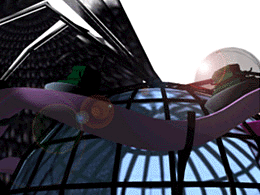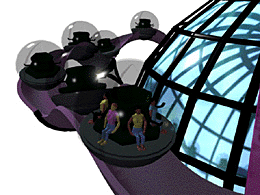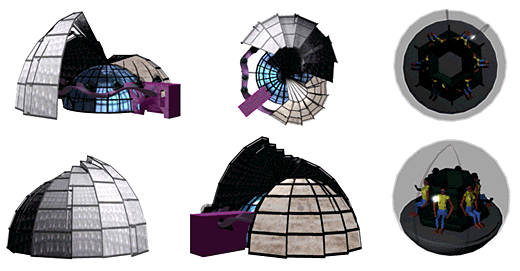|
|
|
The
1993-94 form•Z Joint Study |
||||
|
Honorable mention 1993-1994
Problem:
This project was designed by a graduate student of Architecture participating
in Walt Disney's Imaginations annual competition to design a theme park
ride or attraction. There are very few parameters to the project: it had
to be fun, creative, and applicable to Disney's ideals. Solution: The student chose to design a new pavilion for Epcot Center as an answer to the challenge put forth by the competition. The entire project was conceptualized, rendered and presented using computer technology. Initially, sketch models were done in quick paint mode. Then the structure was fully modeled with enhanced detail and imported into ElectricImage Animation System for rendering. The layering of the model is shown in the examples given. The structure's frame was created by a simple 3D extrusion of the basic form. Each component has its own separate texture and surface characteristic.
The feature attraction of this amusement pavilion is an interactive virtual reality ride called the "Natural Wonder." The ride is guided along a track that weaves an open helix around the pavilion. The track was created in form•Z by sweeping a shape along a spiral path. A section of the track shape was placed along the path and rotated so that the curve of the track always faced upwards. Then a mesh was created between the shapes to create the helix form. The bubble, which is the primary component of the ride, was created using Adobe Illustrator to create a partial silhouette, and then imported into form•Z and rotated about a point to create the base and glass top. The seat was created by using the Boolean operations with one of the human models to derive an ergonomic form that was then used in a sweep rotation operation. Mother Earth was
created as an agent for the virtual reality experience. She was modeled
in form•Z by creating a simple sphere. Her face was texture
mapped in ElectricImage. Her lips were created in form•Z by
first importing a PICT file of the lip outline. Then, crescent shapes
were placed perpendicularly along the outline adjusted to the appropriate
scale. Finally, a mesh was created between the shapes to give the lips
form. The eyes were done by simple 3D extrusions of the primary shape.
|
|
|||
 A
new pavilion for Disney's Epcot Center
A
new pavilion for Disney's Epcot Center 
